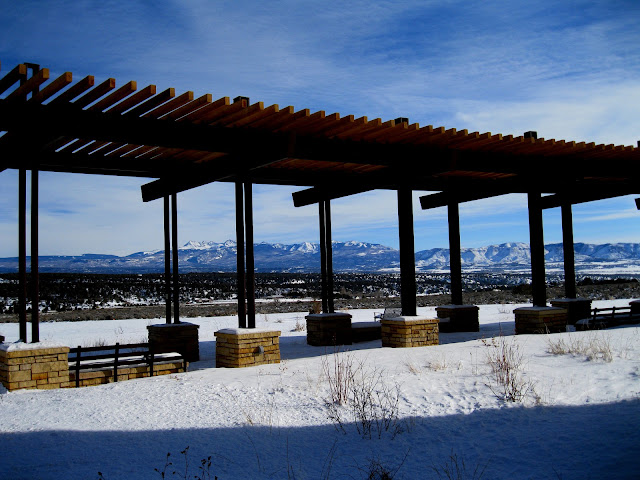The new Mesa Verde National Park Visitor and Research Center opened for visitors in mid December 2012. It is located just outside the main park entrance and there is no charge to enter.
For visitors, it provides an introduction to the park and includes tickets for the main tours and a bookstore. The Chapin Mesa Museum continues as the main place to see artifacts and detailed explanations.
One of the displays inside the entrance discusses the steps taken to make this new facility a very green building. Emphasis was placed on conserving energy and water, and using environmentally friendly materials. The building is highly insulated and has large windows that capture solar heat in winter but prevent heat loss. Photovoltaic panels capture sunlight and convert it to electrical power.
The Ancestral Pueblo archaeology introduction uses a format of the questions of Who are we? Why were we here? How did we live here? And where are we now? The how did we live here segment has the most eye catching display. On one side there is a figure climbing hand and toe holds.
Below the climber, a woman at a seep spring uses a pottery dipper to transfer water to a pottery jar. All of the interpretive signs provide tips where in the park you can see real examples of the images depicted, such as actual seep springs with similar small chiseled basins.
The opposite side of the same display shows a stone worker shaping one of the many sandstone bricks needed for the extensive structures. The development of masonry and building styles is one of the most amazing aspects of Mesa Verde.
The Where are we now exhibit shows a map of where current pueblo people live. One of the main questions about Mesa Verde is what caused the burst of alcove building in the 1200s and why did the Ancestral Pueblo people then abandon the area so abruptly about 1300 AD.
This exhibit includes some audio samples of the languages that are now spoken by Pueblo people. Four different Pueblo languages are mentioned plus the Navajo language.
Most of the new facility is devoted to research and storage of artifact collections. There are large windows that provide a glimpse into the facility but the view is mostly of cardboard boxes. There is a computer display near the windows that provides some information on the types of materials that are stored here.
On the north side of the new Visitor Center there are large ramada shaded areas and benches with good views toward Mt. Hesperus and the LaPlata Mountains. My visit was in late December about 9 days after the opening. Despite the winter conditions there was a steady flow of visitors.








